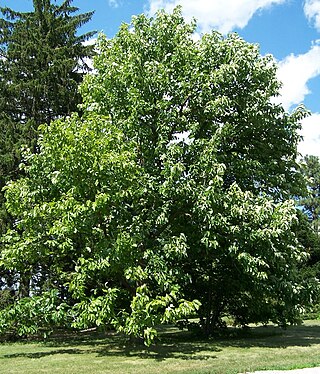
Magnolia acuminata, commonly called the cucumber tree, cucumber magnolia or blue magnolia, is one of the largest magnolias, and one of the cold-hardiest. It is a large forest tree of the Eastern United States and Southern Ontario in Canada. It is a tree that tends to occur singly as scattered specimens, rather than in groves.

Magnolia tripetala, commonly called umbrella magnolia or simply umbrella-tree, is a deciduous tree native to the eastern United States in the Appalachian Mountains, the Ozarks, and the Ouachita Mountains. The name "umbrella tree" derives from the fact that the large leaves are clustered at the tips of the branches forming an umbrella-shaped structure.
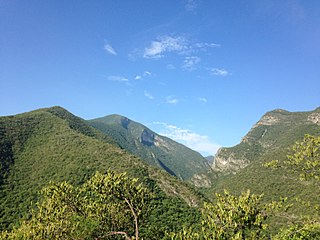
The Sierra Madre Oriental is a mountain range in northeastern Mexico. The Sierra Madre Oriental is part of the American Cordillera, a chain of mountain ranges (cordillera) that consists of an almost continuous sequence of mountain ranges that form the western "backbone" of North America, Central America, South America, and Antarctica.

Magnolia macrophylla, the bigleaf magnolia, is a deciduous magnolia native to the southeastern United States and eastern Mexico. This species boasts the largest simple leaf and single flower of any native plant in North America.
Magnolia guatemalensis is a tree found in the highlands and mountains of Chiapas, Guatemala, El Salvador, and Honduras. It is considered an indicator species of the cloud forest.
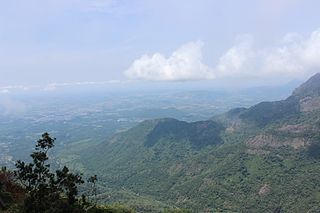
The Nilgiri Biosphere Reserve is a biosphere reserve in the Nilgiri Mountains of the Western Ghats in South India. It is the largest protected forest area in India, spreading across Tamil Nadu, Karnataka and Kerala. It includes the protected areas Mudumalai National Park, Mukurthi National Park, Sathyamangalam Wildlife Sanctuary in Tamil Nadu; Nagarhole National Park, Bandipur National Park, both in Karnataka; Silent Valley National Park, Aralam Wildlife Sanctuary, Wayanad Wildlife Sanctuary, and Karimpuzha Wildlife Sanctuary in Kerala.

Abies religiosa, the oyamel fir or sacred fir, is a fir native to the mountains of central and southern Mexico and western Guatemala. It grows at high elevations of 2,100–4,100 metres (6,900–13,500 ft) in cloud forests with cool, humid summers and dry winters in most of its habitat regime. In the state of Veracruz, it grows with precipitation all year long. The tree is resistant to regular winter snowfalls.
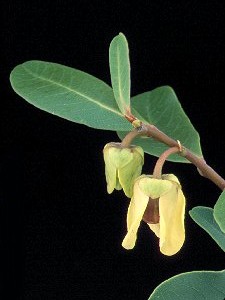
Asimina tetramera, commonly known as the four-petal pawpaw, is a rare species of small tree or perennial shrub endemic to Martin and Palm Beach Counties in the state of Florida. The species is currently listed as endangered under the Endangered Species Act and as endangered by the International Union for Conservation. The four-petal pawpaw is part of the Annonaceae family alongside other Asimina species.
Magnolia iltisiana is a species of plant in the family Magnoliaceae. It is endemic to Mexico. Common names include ahuatoso and yoloxochitl.
Magnolia schiedeana is a species of flowering plant in the family Magnoliaceae. It is endemic to Mexico, where it occurs along the slopes of the Gulf of Mexico.
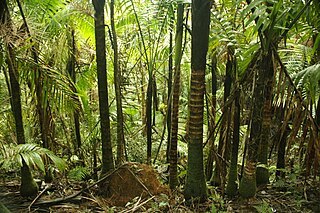
El Toro Wilderness is a 10,254-acre (41.5 km2) federally designated National Wilderness Preservation System unit located within El Yunque National Forest on the Sierra de Luquillo in eastern Puerto Rico. El Toro, named after the highest peak in the forest at 3,524 feet (1,074 m), is the only tropical wilderness in the United States National Forest System. It was created in 2005 by the Caribbean National Forest Act of 2005.

Ficus aurea, commonly known as the Florida strangler fig, golden fig, or higuerón, is a tree in the family Moraceae that is native to the U.S. state of Florida, the northern and western Caribbean, southern Mexico and Central America south to Panama. The specific epithet aurea was applied by English botanist Thomas Nuttall who described the species in 1846.

Magnolia portoricensis is a tree of the Caribbean region. Its vernacular names include jagüilla and Puerto Rico magnolia. It is native to Puerto Rico and it is found in the Toro Negro State Forest. It is an endangered tree and endemic to Puerto Rico. It is a dicot and a part of the family Magnoliaceae. It is an uncommon tree, found primarily in the central and western mountains at 500 to 925 m above sea level.

Syzygium alternifolium is a species of plant in the family Myrtaceae. It is native to North Arcot, Cuddapah, Kurnool, and the Nagari hills, in eastern Chittoor district, India. It has alternate leaves.

The El Cielo Biosphere Reserve is located in the Sierra Madre Oriental in the southern part of the Mexican state of Tamaulipas near the town of Gómez Farias. The reserve protects the northernmost extension of tropical forest and cloud forest in Mexico. It has an area of 144,530 hectares made up mostly of steep mountains rising from about 200 metres (660 ft) to a maximum altitude of more than 2,300 metres (7,500 ft).
Magnolia mexicana, the Mexican magnolia, is a species of magnolia that is found in parts of Mexico, Guatemala and Honduras. The flower is known in parts of Mexico as yolloxochitl, an Aztec word that loosely translates to heart-shaped flower. The Mexican magnolia, often described as having a strong beautiful scent, has been used throughout the years for its medicinal properties, as it is said to have similar compounds to that of the Digitalis medication.
Magnolia krusei is a species of plant in the family Magnoliaceae. It is endemic to Mexico.
Magnolia sororum is a species of flowering plant in the family Magnoliaceae. It is commonly known as vaco. It is native to the mountain forests of Costa Rica and western Panama, and may range into Nicaragua.
Magnolia pedrazae is a species of flowering plant in the family Magnoliaceae. It is endemic to the Sierra Madre Oriental of eastern Mexico.
Magnolia vazquezii is a species of flowering plant in the family Magnoliaceae. It is endemic to the Sierra Madre del Sur of Guerrero state in southern Mexico.












